Claude H. Townsend BCMG
Euphorbia millii
Common name: Crown of Thorns, Christ Crown,
Rosa (Corona) Espinas
Scientific name: Euphorbia milii (old name: E. splendens)
The Crown of Thorns is a member of the Euphorbiaceae (Spurge family)
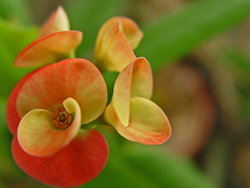
Crown of Thorns flowers |
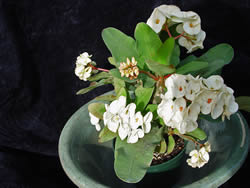
Crown of Thorns WHITE |
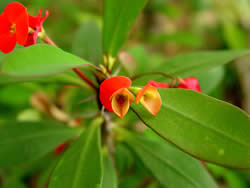
Bi-color new bloom of Crown of Thorns |

Close-up of WHITE Crown of Thorns flower |
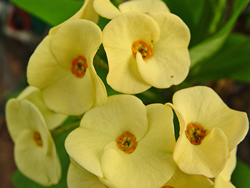
Close-up of YELLOW Crown of Thorns |
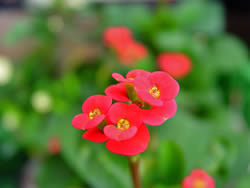
HOT PINK flowers of a Crown of Thorns |
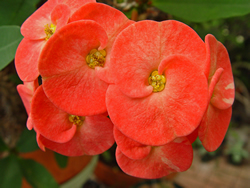
HOT PINK flowers of Crown of Thorns |
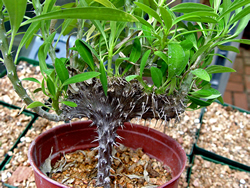
I wonder why it is named Crown of Thorns!! |

Pruning is fun with the Crown of Thorns plants. |
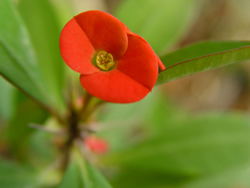
Single Flower of Crown of Thorns |
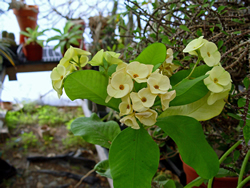
YELLOW Crown of Thorns |
|
History: King Juba 11 (50 BC to 19 AD) of Numidia (present day
Algeria)
was the first person to collect succulent type Euphorbia and named
the plant
after his Greek physician Euphorbus. Milii Was named for Baron
Milius,
once governor of the island of Bourbon, who was responsible for
introducing
the plant into cultivation in France about 1821.
The common name refers to legend that a crown of thorns was placed
on
Christ’s head at the crucifixion. It could have been used
as it was
introduced to that area from Madagascar some years before the
time of Christ.
Temperature range well above frost
Light Bright light to full sun
Water often in summer -- 2 or 3 time a week in the sun; in winter
when the plant is inside water less often.
The Euphorbia milii is a woody succulent with thorns. The plant
ranges in height from a few inches to 6 7 foot tall single stalks
or small shrub the size of a soccer ball. Some make a perfect
plant for hanging basket because they cascade down.
Flowers range in color from deep red to white to multicolor and
in size from
tiny, less than size of a BB, to one-half inch. On some of the
older types you may find red spots on the leaves. Leaves are found
mostly on the tips of the plant where flowers appear either single
or in pairs. In China where it is called “PoySean”
“Poy” means 8 and “Sean” means saint.
If the plant has 8 flowers in a bundle, you will be lucky. For
many years I have had these plants in my collection and find it
is quiet easy to propagate from seeds, grafting or cuttings. I
prefer rooted cuttings. It is quick and easy. Take the cuttings
from the top portion of the plant, remove most of the leaves add
Rootone or Hormondin and let dry for a couple days in low light.
Then place in a 50 percent mixture of potting mix and sand. Keep
the potting mix damp BUT NOT WET in the shade. In a couple weeks
you will have flowers.
As for insects, you may have some scale, mealy bugs, and sometime
aphids. But usually this only occurs on weak or sick plants. I
use two tablespoons of liquid soap in a quart of water.
Plant in well drained soil. If roots stay too wet the plants will
drop all leaves and die.
Caution:: This plant is in the Euphorbia family and is a mild
poison. It bleeds
a white sap that when coming in contact with some people’s
skin reacts like Poison Ivy. When the sap comes in contact with
eyes, wash with running water and see a doctor. Never plant near
a fish pond since the exudate from broken roots will kill fish.
For more information about this plant Contact: Claude at C&E
Cactus
210 655 8959 or ctownsend@satx.rr.com
Ref. T. Ombrello UUC Biology Dept.
|















